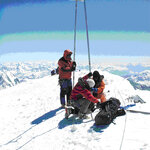Oceanography
Sediment cores retrieved from the Arctic’s deep-sea floor by the Integrated Ocean Drilling Program’s Arctic Coring Expedition (ACEX) report that the Arctic Ocean changed from a landlocked body of water (a ‘lake stage’) through a poorly oxygenated ‘estuarine sea’ phase to a fully oxygenated ocean at 17.5 million years ago during the latter part of the early Miocene era.
The authors attribute the change in Arctic conditions to the evolution of the Fram Strait into a wider, deeper passageway that allowed an inflow of saline North Atlantic water into the Arctic Ocean. Scientists believe that the…

Monitoring the saltiness of the ocean water could provide an early indicator of climate change. Significant increases or decreases in salt in key areas could forewarn of climate change in 10 to 20 years time. Presenting their findings at a recent European Science Foundation (ESF) conference, scientists predicted that the waters of the southern hemisphere oceans around South Africa and New Zealand are the places to watch.
Palaeoclimate data shows that the ocean's currents (like the Gulf Stream and its North Atlantic deep water partner) are capable of shifting gears very suddenly, but until…

Huge waves that struck Reunion Island and coastlines across Indonesia earlier this month all originated from the same storm that occurred south of Cape Town, South Africa, and were tracked across the entire Indian Ocean for some 10 000 kilometres over a nine-day period by ESA's Envisat satellite.
Picture taken on 14 May 2007 in Saint-Leu, on the French Indian Ocean island of Reunion, of a giant wave breaking on the coast. Credits: AFP
Waves reaching up to 11 metres devastated France's Reunion Island in the Indian Ocean when it slammed into the southern port of Saint Pierre on 12 May. Six…

A novel analysis of water flow in the Southern Ocean surrounding the Antarctic is revealing previously hidden structures that are crucial in controlling the transport of drifting plants and animals as well as the distribution of nutrients and pollutants that affect ocean life.
Researchers at the University of New South Wales in Australia and the Universitat Paderborn in Germany discovered that barriers to currents, which can lead to swirling gyres and eddies that trap material for long periods, may escape detection with traditional analyses that concentrate on monitoring average water flow…

NASA satellite data have helped scientists solve a decades-old puzzle about how vast blooms of microscopic plants can form in the middle of otherwise barren mid-ocean regions. A research team led by the Woods Hole Oceanographic Institution, Woods Hole, Mass., has used the data in its work to show that episodic, swirling current systems known as eddies act to pump nutrients up from the deep ocean to fuel such blooms.
Dennis McGillicuddy, a Woods Hole oceanographer and leader of the Eddies Dynamics, Mixing, Export, and Species composition (EDDIES) project, found that ocean productivity was…
Scientists have observed the first evidence that the Southern Ocean's ability to absorb the major greenhouse gas, carbon dioxide, has weakened by about 15 per cent per decade since 1981.
In research published today in Science, an international research team – including CSIRO's Dr Ray Langenfelds – concludes that the Southern Ocean carbon dioxide sink has weakened over the past 25 years and will be less efficient in the future. Such weakening of one of the Earth's major carbon dioxide sinks will lead to higher levels of atmospheric carbon dioxide in the long-term.
The Bureau of Meteorology's…

The small ice caps of Mont Blanc and the Dôme du Goûter are not melting, or at least, not yet. This is what CNRS researchers have announced in the Journal of Geophysical Research. At very high altitudes (above 4200 meters), the accumulation of snow and ice has varied very little since the beginning of the 20th century. But if summer temperatures increase by a few degrees during the 21st century, the melt could become more marked, and could affect the "permanent" ice fields.
Figure 1 – Researchers from the Glaciology Laboratory taking an ice core sample on top of Mont Blanc, in 2005. © C.…

The origin and movement of waves reaching up to 11 metres that devastated France's Reunion Island in the Indian Ocean on Saturday evening have been detected with ESA's Envisat satellite.
The waves that thrashed the southern port of Saint Pierre, leaving two fishermen missing, causing several piers to collapse and flooding several homes and businesses, originated south of Cape Town, South Africa, and travelled northeast for nearly 4000 km over a period of three days before slamming into Reunion Island.
Dr Bertrand Chapron of IFREMER, the French Research Institute for Exploitation of the Sea,…
Threatened coral reefs could be given a helping hand by establishing marine reserves, according to a research team led by the University of Exeter. Marine reserves have already proved to be a successful way of protecting marine life against commercial fishing. Marine reserves could also help in the recovery of corals, which are already suffering the effects of climate change and over-fishing.
Adult male of the queen parrotfish, Scarus vetula, one of the most important grazers on Caribbean coral reefs. Credit: Photograph courtesy of Evan D’Alessandro.
Funded by the Natural Environment…

A study released today provides some of the first solid evidence that warming-induced changes in ocean circulation at the end of the last Ice Age caused vast quantities of ancient carbon dioxide to belch from the deep sea into the atmosphere. Scientists believe the carbon dioxide (CO2) releases helped propel the world into further warming. The study, done by researchers at the University of Colorado, Kent State University and Columbia University's Lamont-Doherty Earth Observatory, appears in the May 10 advance online version of the leading journal Science.
Atmospheric CO2, also produced by…